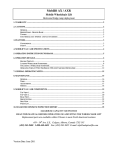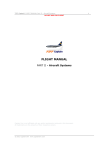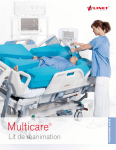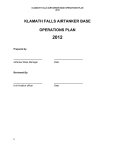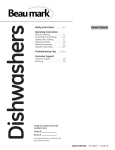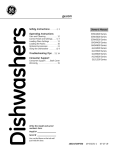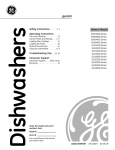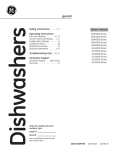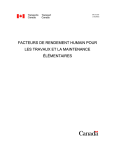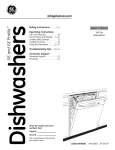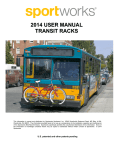Download Adaptive Engineering AXR User's Manual
Transcript
Mobilift AX and AXR Operation and Maintenance Manual adaptive ENGINEERING LTD. 419 – 34th Ave. S.E., Calgary, Alberta, Canada T2G 1V1 (403) 243-9400 1-800-448-4652 Fax: (403) 243-9455 [email protected] -1- Mobilift AX / AXR - Mobile Wheelchair Lift Horizontal bridge ramp deployment 1. WARRANTY.............................................................................................................................................................................. 2 2. CAUTIONS................................................................................................................................................................................. 3 GENERAL ........................................................................................................................................................................... 3 BRIDGE RAMP - GROUND RAMP ....................................................................................................................................... 3 TOWING ............................................................................................................................................................................. 3 COUNTERBALANCE GAS CYLINDERS ................................................................................................................................ 3 3. FEATURES ................................................................................................................................................................................ 4 CONVENIENCE ................................................................................................................................................................... 4 SAFETY .............................................................................................................................................................................. 4 4. MOBILIFT AX / AXR SPECIFICATIONS.......................................................................................................................... 5 5. OPERATING INSTRUCTION PICTOGRAMS ................................................................................................................. 6 6. OPERATION DETAILS .......................................................................................................................................................... 7 TO MOVE THE LIFT: .......................................................................................................................................................... 7 TO LOAD A PASSENGER IN A WHEELCHAIR ONTO THE AIRCRAFT:............................................................................... 9 TO ASSIST A WHEELCHAIR TRAVELER OFF THE AIRCRAFT: ........................................................................................ 12 OPERATION OF THE LIFT WITH THE BEECH 1900 AND FAIRCHILD METROLINER ...................................................... 13 7. GENERAL OPERATING NOTES....................................................................................................................................... 16 8. MAINTENANCE..................................................................................................................................................................... 17 GENERAL ......................................................................................................................................................................... 17 TIRES ................................................................................................................................................................................ 17 ADJUSTMENTS ................................................................................................................................................................. 18 SPRINGS ........................................................................................................................................................................... 19 9. MOBILIFT AX / AXR COMPONENTS ............................................................................................................................. 20 TOP VIEW 1...................................................................................................................................................................... 20 TOP VIEW 2 ..................................................................................................................................................................... 21 REAR VIEW ...................................................................................................................................................................... 22 DRIVE SYSTEM ................................................................................................................................................................ 23 SIDE VIEW........................................................................................................................................................................ 24 PARTS LIST ...................................................................................................................................................................... 24 10. SUGGESTED MINIMUM INSPECTION REPORT...................................................................................................... 26 MAXIMUM CAPACITY 600 POUNDS READ THIS MANUAL BEFORE OPERATING OR ADJUSTING THE WHEELCHAIR LIFT Replacement parts are available within 24 hours to most North American locations from adaptive Version Date October 25, 1999 ENGINEERING LTD. th 419 – 34 Ave. S.E., Calgary, Alberta, Canada T2G 1V1 (403) 243-9400 1-800-448-4652 Fax: (403) 243-9455 [email protected] -2- 1. WARRANTY Adaptive Engineering Ltd. Warrants each Mobilift AX/R to be free from manufacturing or material defects for two years from the date the product was put into service. Damages caused by vandalism or abuse are not covered by this warranty. For assistance, parts or repair information please call 1-800-448-4652 or 1-403-243-9400. -3- 2. CAUTIONS: General 1. It is the responsibility of operating staff to ensure that the aircraft is not damaged while the wheelchair lift is in use. 2. All precise maneuvering (i.e. alignment with aircraft or parking) should be performed using the push handles. Do not tow lift too close to aircraft. 3. Do not attempt to crank up the lift deck from on the lift. A lift operator on the ground is required. 4. When parked, the lift should be cabled and locked to a permanent structure if it is accessible to vandalism or susceptible to jet blasts. (see general operating notes.) 5. The deck crank handle should always be returned to the vertical position and folded in except when it is actually being cranked. 6. Passengers on wheelchairs must be accompanied by an attendant on the lift to stabilize the wheelchair while the lift is raised and lowered. 7. When used with the Beech 1900 C and D models and the Fairchild Metro, a spotter must be used to guard the propeller. The configuration of both planes requires particular care. Please refer to the end of the Operating section for detailed instructions Bridge Ramp - Ground Ramp 1. Do not attempt to extend or retract the ramps from on the lift deck or from inside the aircraft, this must be done by the lift operator on the ground. 2. The bridge ramp must be supported by at least a 3” overlap with the floor of the aircraft for the entire width of the ramp. 3. The end of the ground ramp should rest flat on the ground or it may become damaged when loading or unloading passengers from the lift deck. 4. Close deck gate prior to elevating deck. Towing 1. No passengers or equipment are to ride on lift while being towed. 2. Maximum towing speed is 8 km/hr (5 mph). 3. Wheels must be fully lowered prior to towing. Counterbalance Springs and Gas Cylinders 1. A large amount of energy is stored in the springs and gas cylinders used for the deck and wheel counterbalances (respectively). Improper servicing can result in serious injury. In all cases, contact Adaptive Engineering Ltd. for detailed information regarding servicing of these components. -4- 3. FEATURES Convenience Cranking System The high-efficiency crank system is counter-balanced to allow two adults to be lifted to maximum height with very little effort in less than 45 seconds. Self-leveling Ground Contacts Automatic self-leveling of lift on uneven ground. Tow Bar Tow bar with integral brake release allows towing by tarmac tractors. Spare Tire A spare tire is attached to the Mobilift. The “quick release” design allows a wheel to be changed in less than 2 minutes without tools. Safety Outriggers Safety features that reduce the chance of overturning should a jet blast strike the lift. The lift is designed not to overturn in a 90 mile per hour wind. Deck Interlock The lift deck cannot be raised unless the outriggers are extended, and the ground ramp gate is latched. Bridge Ramp Gate The bridge ramp gate opens automatically when the bridge ramp is lowered onto the aircraft doorsill. Parking Brake Automatically prevents the lift from rolling when unattended. Emergency Lowering Crank The lifting mechanism of the Mobilift AX / AXR is designed to lock in place in the unlikely event of a mechanical failure. The self-braking system can be overridden using the emergency lowering crank to lower the deck to the ground. Bumper Pad Non-marking urethane bumpers cushion inadvertent contact with the aircraft reducing risk of damage. -5- 4. MOBILIFT AX / AXR SPECIFICATIONS Model Weight Height Width Length Lift platform size Ground ramp length Bridge ramp length Maximum lifting height Minimum lifting height Capacity Materials Typical deploying time Typical lifting time Minimum safety factors Features Options Service requirements Parts delivery Patents AX AXR 880 lb. 920 lb. 77" 114" 72" 72" 90" 90" 15"x 60" 15"x 60" 48" (slope 1:11) 48" (slope 1:11) 77" 77" 73" 110" 29" 29" 600 lb. (tested to 3,000 lb. - certified test results available on request) 6061 T6 aluminum space frame construction stainless steel cables (7x19 aircraft grade) powder coated steel sealed ball bearings industrial duty wheels stainless steel fasteners and fittings under 1 minute under 45 seconds to maximum height cables: 12.0 other load-carrying components: 4.0 easy set up and operation by one attendant automatic self-leveling on uneven ground auto fail-safe crank with 2 load-activated drum brakes automatic parking brake to prevent rolling interlocked outrigger/crank system designed to withstand 90 mph jet blast quick change spare tire cycle counter slip-resistant surfaces reflective marking tape shed enclosure color of powder-coated components Markings canopy on AX minimal, can be handled by technician Overnight 5,040,638 and 4,926,973 (others pending, all rights reserved) Specifications subject to change without notice. -6- -7- 6. OPERATION DETAILS Bracketed numbers refer to parts that are labeled on figures in Section 8. Operators who are using the lift with the Beech 1900 and Fairchild Metroliner, please refer to special instructions at the end of this section. To Move The Lift: I. Raising Lift onto Wheels a) The first step is to crank the lift up onto its wheels. To do this, turn the wheel crank handle [16] clockwise until the wheels are in the full down position. b) Visually inspect the main tires to make sure they are not under-inflated. If a tire is underinflated, the spare can be used or the tire can be re-inflated to the proper operating pressure. (See Tires, in the Maintenance Section). c) Check that the outriggers are locked in the fully retracted position. The locking handles [42] must be engaged into the keyhole slots [43] on the positioning handles [43] to prevent vibrations from causing the outriggers to extend while moving the lift. II. Moving Lift Using Push Handles a) Pull both push handles [17] down to release the automatic parking brake. The purpose of this parking brake is to prevent the lift rolling when it is not in use. If there is any indication that the brake is not operating properly, it must be repaired immediately. b) To move the lift, apply a slight downward force on the push handles and push or pull as necessary. (If the lift is being pushed on rough ground it can be quite noisy from cable rattle. This is normal.) IMPORTANT: • All precise maneuvering (i.e. alignment with aircraft or parking) should be performed using the push handles not a tractor on the tow bar. Towing Lift Behind Vehicle The lift can be towed behind a vehicle at a maximum speed of 8 km/hr (5 mph). a) Lowering the tow bar [20] to attach to the towing vehicle will automatically release the parking brake. b) The tow bar is designed with a rubber cushioned tow ring, 17/8 inches inside diameter at a height of 18 inches. Contact Adaptive Engineering if your towing equipment does not match the supplied tow ring. IMPORTANT: • No passengers or equipment are to ride on lift while being towed. • Maximum towing speed is 8 km/hr (5 mph). • Wheels must be fully lowered prior to towing. • Perform all fine maneuvering with the push handles only. Do not tow lift too close to the aircraft. -8- III. Aligning Lift with Aircraft a) Carefully push the lift toward the aircraft and align the ramp with the doorway. b) If there are stairs in place, bring the lift as close as possible to the stairs, there is a bumper [47] on the front of the tow bar to reduce the chance of damaging the stair or lift if contact is made. c) If there are no stairs in place, bring the lift close to the fuselage of the aircraft using caution not to push the end of the deck under the fuselage, see figure below. The high alignment bumper [46] will set the minimum spacing for the Boeing 737 and MD80. Up to 2’ away Contact not necessary Possible damage when lift too close. Alignment bumper, proper positioning d) Once the lift is in position, release the push handles allowing them to return to the upright position automatically applying the parking brake. e) Extend the outriggers by releasing the safety locking handles and pulling the outrigger handles outward to the fully extended position. As a safety feature, the lift deck cannot be raised unless the outriggers are extended. The two outriggers on each side of the lift are interconnected to make them move at the same time. Watch that the outriggers do not contact the propeller, landing gear or other obstacles while extending. f) Lower the lift to the ground by turning the wheel crank handle [16] counter-clockwise. Note that the lift is designed to rest on the two outriggers of the tow bar end, and the automatic leveling device on the push handle end of the lift. The two outriggers on the push handle end of the lift contact the ground but do not take load unless strong tipping forces are applied to the lift. Cautions: • Use extreme caution when approaching the aircraft to avoid damaging contact between the lift and any part of the aircraft. • Perform all maneuvering near the aircraft with the push handles only. Do not tow the lift directly up to the aircraft. -9- IV. Stowing the Lift a) Park the wheelchair lift away from the aircraft with the wheels up, or in an enclosure, so there is no possibility of it causing damage to aircraft or other airport equipment. b) If the lift could be subjected to high winds it should be fastened securely to a permanent fixture or be stowed inside an enclosure. An optional enclosure is available from the manufacturer. c) The Mobilift is designed for durable reliability but it could be damaged by foreign object debris (FOD). The lift should be stored at a location to minimize this hazard. To Load A Passenger In A Wheelchair Onto The Aircraft: I. Transferring a Passenger to a Boarding Chair Consult the boarding chair manufacturer’s instructions for the proper procedures for transferring passengers to and from the boarding chair. II. Lowering the Ground Ramp and Opening the Deck Gate Release the ground ramp [12] by unlatching the blue handgrip from its keyhole. Pivot the ground ramp down to ground level. Open the deck gate [44] by unlatching the deck gate latch [45] on the lifting crank side of the lift, and allow the gate to swing fully open. IMPORTANT: • The end of the ground ramp should rest flat on the ground or it may become damaged when loading or unloading passengers from the lift deck. - 10 - III. Positioning the Passenger and Attendant on Lift The fore and aft location of the aircraft entrance will determine whether the passenger should be loaded onto the lift facing towards or away from the aircraft. If the entrance door is forward of the passenger seating, the passenger should be backed onto the lift facing away from the aircraft. If the entrance door is aft of the passenger seating, the passenger should be loaded onto the lift facing towards the aircraft. SAAB 340, Dash 8, Beech 1900, etc. ATR 42, Jetstream 31, 32, etc. When the passenger and attendant are positioned properly on the deck with the wheelchair brakes locked, the deck gate [44] is then closed and relatched. The passenger should keep their arms on their laps in front of them to avoid interference with the bracing members of the ramps. The ground ramp remains in the lowered position until the entire loading or unloading process is complete. People with crutches or canes can also use the lift. They should stabilize themselves with the deck handrails while the deck is raised and lowered. IMPORTANT: • Passengers on wheelchairs must be accompanied by an attendant on the lift to stabilize the wheelchair while the lift is raised and lowered. • It is the responsibility of the operator to determine whether other non-wheelchair passengers require an attendant while on the lift. - 11 - IV. Raising the Lift To raise the deck, pull the deck crank handle [15] out and turn it clockwise until the deck is 2 or 3 inches above the sill of the aircraft door. (Note: When the deck height and lift position for a particular aircraft is established, the operator may mark the deck height on the lift post for future convenience.) IMPORTANT: • Watch to ensure that the deck and its attachments do not contact the aircraft when raising or lowering the deck. • The deck crank should always be returned to the vertical position and folded in except when it is actually being cranked. • While cranking, keep a slight outward pull on the handle to prevent it folding in. • Do not attempt to crank up the lift deck from on the lift. A lift operator on the ground is required. • The lift may squeak under normal operating conditions. Please refer to the Maintenance section for lubrication information. V. Extending the Bridge Ramp With the deck set 2 or 3 inches above the sill of the aircraft door, the bridge ramp [13] can be extended into the doorway by pulling down and turning the bridge ramp extension crank [19] counterclockwise. Exercise caution while extending the ramp that it is properly aligned with the doorway and no part of the ramp contacts the aircraft. The bridge ramp has sideways float allowing precise sideways positioning of the bridge ramp while extending. Several inches of sideways float allows the attendant to center the ramp within the doorway by pushing or pulling on the side of the ramp. Ensure that the end of the bridge ramp is extended so that it overlaps the sill by at least 3" for the entire width of the ramp. When the bridge ramp is in position, the deck must be lowered (turning the lifting crank [15] counter-clockwise) so that the end of the bridge ramp rests securely on the doorway sill. When in position, the bridge ramp gate [52] will automatically be fully open. Cautions • Make sure the bridge ramp is properly aligned with the doorway. Extending the ramp into the side of the aircraft can cause damage to the aircraft. • The entire width of the bridge ramp must overlap the doorway sill by at least 3". • Do not attempt to extend or retract the bridge ramp from on the lift deck, this must be done by the operator on the ground. • If the bridge ramp gate does not automatically fully open, re-check the ramp overlap and deck height. • The AX lift can be used to transfer passengers to aircraft floor heights of between 29” and 73”. The AXR can access aircraft floor heights of between 29” and 110”. - 12 - VI. Transferring the Passenger to the Aircraft With the bridge ramp in proper position, the attendant on the lift can move the passenger across the ramp and into the aircraft. VII. Retracting the Bridge Ramp With the passenger and attendant fully inside the aircraft and clear of the bridge ramp, the operator raises the deck 2 or 3 inches then fully retracts the bridge ramp by pulling down and turning the bridge ramp extension crank clockwise. IMPORTANT: • Do not attempt to crank up the lift deck from on the lift. A lift operator on the ground is required. • The bridge ramp must be fully retracted to prevent interference with bracing members when lowering deck. VIII. Lowering the Deck Once the bridge ramp is fully retracted, the deck can be lowered by swinging the deck crank handle out and turn it counter-clockwise until the deck is in the full down position. IX. Raising and Latching the Ground Ramp When the deck is fully lowered, the ground ramp is raised and latched into place by inserting the latch handle into the slot on the ramp. X. Raising Lift onto Wheels See Chapter 6, “To Move the Lift” section, Item I. XI. Retracting and Locking Outriggers Once the deck is lowered and the Mobilift AX / AXR is raised onto it’s wheels, the outriggers can be retracted and locked into position with the safety handles. XII. Releasing the Brake and Moving the Lift From Aircraft To move the lift, pull down and apply a slight downward force on the push handles and push or pull as necessary. To Assist A Wheelchair Traveler Off The Aircraft: The steps for assisting a person in a wheelchair off the aircraft are the reverse of those described above. - 13 - Operation of the Lift with Beech 1900 and Fairchild Metroliner Operators using either of these aircraft must note the following special instructions for these difficult-toaccess planes. In both cases, an experienced spotter must be positioned at the propeller to protect it, because of the proximity of the spinner tip to the airplane door. Beech 1900 1. The Mobilift should be moved towards the aircraft in line with the door, and stopped when lift post A is 10 to 12 inches away from the spinner tip. 2. Spinner must not project inside of a line drawn from lift post A to lift post B. (If it does, it could be damaged by the handrail as the lift is raised.) See drawing below. 3. The bridge ramp will extend to cover the distance to the sill. When deploying the bridge ramp, bring it in above the support arms for the door cables until it sufficiently overlaps the sill and then lower it down. The spotter must watch ramp, spinner and air stair cables during this process. The cables may be need to be held apart to allow the ramp to pass. Reverse this step by raising the ramp up clear of the support arms before retracting it. - 14 - Fairchild Metro With the Metro proceed as follows, referring to diagrams at the end of these instructions: 1. Station an experienced person at the propeller to be sure the lift does not touch the blades or spinner. 2. The purpose is to get the lift pointing at the door, but sitting at an angle of about 10o . In order to do this, lift post A must be about a foot ahead of the spinner tip - that is between the spinner and the plane. 3. One blade of the propeller should be set at 5 o'clock (when facing the spinner) to allow the right shroud to sit between the blades once the lift is in position. 4. The lift is brought to the plane door on a curve around the spinner. See the path of movement in the diagram. Do not contact the spinner with the lift post A. The shroud point C will clear the outside propeller blade by about 3 inches as it moves past. As the lift is being moved, watch the blades to avoid contact with the shroud on the right side of the lift. The shroud will sit exactly between the two propeller blades when the lift is in position. 5. The spinner must not project inside a line drawn from lift post A to lift post B. (If it projects in, it will be hit by the deck handrail when the lift is being raised, which could seriously damage the spinner.) 6. The lift is now ready for use with a wheelchair and can be operated as described in the manual. 7. Note that the guard person remains at the propeller through the entire process to ensure that the lift does not contact the plane while the deck and ramp are moving. 8. The bridge ramp will go into the door on an angle (the ramp moves side to side to allow this). The spotter should watch and help guide it into place if necessary. Watch the ramp handrails, not just the ramp end. Remember to get 3 full inches of overlap onto the sill. It may be necessary to hold the air stair cables apart to allow the ramp to pass. 9. Use the same path of travel when moving the lift away from the plane - again guarding the spinner and propeller. 10. It is strongly recommended that the operator take time to practice this before doing it with the additional pressure of a short turn time and a passenger waiting. - 15 - Fairchild Metroliner Path of travel follows lift post A Mobilift positioned for use 8. GENERAL OPERATING NOTES: - 16 - a) When cranking the lift, the operator should maintain a slight outward pull on the crank handle. This ensures the handle does not tend to fold while cranking. b) When cranking the lift up, the more weight there is on it, the harder it will be to crank. Cranking the deck down will feel about the same as cranking up because of the patented load activated braking system. The brakes are actually applied by the load on the deck, so increased load on the deck makes it harder to crank down. This is an essential safety feature of the drive system. c) The braking system is very reliable, but additional safety is provided by folding the hand crank, which locks the drive mechanism. This is why the hand crank must always be folded when the lift is not actually being cranked. d) All of the controls on the lift were designed for simplicity, reliability, and ease of use by an operator wearing heavy mitts in cold weather. Critical components of the lift have been tested to -60 degrees Fahrenheit. e) Persons in wheelchairs must feel safe when being lifted. Adaptive Engineering wheelchair lifts have an established reputation for reliability and safety. If the disabled traveler appears uncertain, the operator should assure them that each and every lift is load tested to over 3,000 lb. before it is placed in service. (This is about the weight of a mid-size car.) Also, there is no single component in the lift that can allow the deck to drop in the event of failure. The lift is designed, built and tested according to regulations governing devices that lift people. - 17 - 7. MAINTENANCE The wheelchair lift is safety equipment. It must be inspected officially at least once a year, or in high use areas, after every 500 uses. In addition, the day-to-day operator of the lift should make a habit of glancing at the main lifting cables on the left side of the lift for any sign of wear or damage. As with any piece of safety equipment, the Mobilift AX / AXR must be on a documented preventive maintenance program. A suggested inspection report form is included at the end of this manual, airlines and airports with an established preventive maintenance system can incorporate these requirements as necessary. The lift is designed and manufactured to minimize maintenance work. All exposed materials are aluminum, stainless steel, polymers, powder-coated or electroplated steel. Cleaning Sand and other debris may build up on the deck of the Mobilift and affect the bridge ramp operation. It is recommended that the aluminum deck of the unit be cleaned with pressurized air or water on a regular basis. Lubrication If you experience operating squeak while raising or lowering the deck,WD40 or LPS can be used on the deck roller guides (75). This squeak is normal and is not a safety or operational concern. The inside of the bridge ramp drive capstan (51) may also be lubricated if necessary. There are no other lubrication points on the lift. Wheel bearings are sealed and do not require lubricant. The brakes may also squeal occasionally as the lift is being cranked, in the same way that automobile brakes squeal. This is normal, and UNDER NO CIRCUMSTANCES should these brakes be cleaned with solvents nor should they be lubricated with products such as WD40, LPS, Crown or silicon. Do not use any lubricants under either shroud. The serial numbers for the lifts are on the lower left rear of the lift. This serial number should be used in recording all maintenance inspection and work. It must also be given when ordering parts. The lift counter reading must be recorded for any inspection or maintenance work. The counter can be viewed through a hole in the side of the counterbalance shroud, which is on the same side of the lift as the wheel crank. For the number of uses, divide the cycle counter reading by 5. General The Mobilift AX / AXR is intentionally designed with open accessible parts and simple mechanisms. Adjustments and replacements can be made by any experienced mechanic using standard tools and due care. If uncertainties do occur, contact Adaptive Engineering Ltd. for assistance. Tires I. Tire Pressure Regularly check that the tires are inflated to a pressure of 200 kPa (30 p.s.i.). - 18 - II. Wheel Bearings Wheel bearings are sealed and do not require any lubrication III. Spare Tire In the event that the spare tire is required, the following procedure should be followed. a) Crank the lift down off of its wheels. Continue cranking until the tires are clear of the ground. b) The spare tire can be removed from its mount by removing the retaining pin and sliding it off of the mounting axle. c) Disengage the parking brake on the tire being changed by pulling down on the push handle. d) Remove the retaining pin and extract the axle from the tire to be changed. Remove the tire and replace it with the spare tire. Reinsert the axle and retaining pin. e) Have the tire serviced immediately and reinstall on the lift so that a spare tire is available. IV. Tire Replacement Should the tires become excessively worn or weathered, replacement tires (size 4.80/4.00-8 or K-301M-023) can be obtained from any tire supplier. It is recommended that a tube be used even with tubeless tires for additional reliability. The Mobilift AX / AXR is delivered with special valve stem caps that provide additional sealing reliability. These should be replaced with any new tires. Adjustments The adjustments covered in this section refer only to those items where parts are not required. If new parts are to be installed, the parts will be supplied by the manufacturer with detailed instructions on installation and adjustment. If the lift has been vandalized or damaged such that welding or machining is required, it must be carried out by qualified trades people, who should also refer to the manufacturer's literature and discuss the repairs with the manufacturer. I. Lifting/Return Cables As illustrated, the lifting cables [22] go from the main winding drum [32] up through the top of the drive shroud over the upper lift pulleys [39], then down under the deck. These four cables are critical because each supports 1/4 the load of the lift. If the inspection indicates need for adjustment, contact the manufacturer for detailed instructions. II. Deck Paralleling Cable Adjustments If the inspection indicates that the deck is not level or that the paralleling cables require adjustment, contact the manufacturer for detailed instructions. III. Parking Brakes The parking brakes are an important safety feature of the lift. They hold in the "off" position to move the lift, when the push handles are released the brakes apply automatically. The brakes can also be released by pulling down the tow bar [20]. Adjust the brake cables so that they are tight enough to pull the brake cylinder clear of the tire but are slack when the push handles and the tow bar are in the upper (braking) position. If the brakes do not release, or drag when the push handles or tow bar are down, the cables - 19 require tightening. Since the brake can be released with either the tow bar or push handles, both systems should be checked. Adjust each brake release system individually (4 cables overall). Retighten all cable adjustment locking nuts. If the brakes do not provide sufficient braking force when the push handles and tow bar are released, the following adjustment should be performed. a) With the tow bar and push handles released, check that both cables to each brake lever are slack. b) If one or more cables are still tight, check that there is no damage to the cables or the lift that may have caused this tension. Check the routing of the cables. If no damage is present and the routing is correct, adjust the tight cable(s) until slack. Check that the brake is still clear of the tire when the brake is released and retighten all cable adjustment locking nuts. IV. Outrigger Paralleling Cable Adjustment The two paralleling cables on each side of the lift should be adjusted together so that the outriggers reach the extension and retraction limits at the same time. The cables should be adjusted to provide enough tension to stay on their sheaves but be loose enough that they do not bind. Be sure to retighten all cable anchor locking nuts and run the outriggers through at least one full cycle after adjustment to check function. Springs Two springs are used to counterbalance the load of the deck platform. These components are designed to provide trouble-free operation and long life. Should a spring break, the deck crank will become difficult to operate, but the lift does not have to be taken out of service. Since the spring systems can store large amounts of energy, improper servicing can result in serious bodily injury. In all cases, contact Adaptive Engineering for replacement parts and procedures. Gas Cylinders Gas cylinders (also known as gas springs) are used to assist with raising the lift onto its wheels. If the cranking force to raise the lift onto its wheels becomes too high one or more of the gas cylinders may need replacing. Since gas cylinders can store large amounts of energy, improper servicing can result in serious bodily injury. In all cases, contact Adaptive Engineering for replacement parts and procedures. IMPORTANT: • Do not attempt to replace or adjust the steel springs or gas cylinders without complete and proper instructions from Adaptive Engineering Ltd. - 20 - 9. MOBILIFT AX / AXR COMPONENTS Top View 1 (Deck not shown) - 21 - Top View 2 - 22 - Rear View - 23 - Drive System - 24 - Side View - 25 - Parts List 11.Main Deck 12.Ground Ramp 13.Bridge Ramp 14.Corner Post 15.Deck Crank Handle 16.Wheel Crank Handle 17.Push Handle 18.Ground Ramp Release Handle 19.Bridge Ramp Extension Crank 20.Tow Bar 21.Return Cable 22.Lifting Cable 23.Deck Handrail 24.Drive Shroud 25.Drive Chain 26.Balance Spring 27.Front Lift Brake 28.Rear Lift Brake 29.Brake Adjuster 30.Frame Adjuster 31.Drive Frame 32.Main Cable Drum 33.Steady Bearing 34.Return Pulley 35.Main Travel Wheels 36.Idler Wheel 37.Idler Caster, pivoting 38.Lift crank over-ride 39.Lift Pulley 40.Bridge Ramp Handrail 41.Outrigger Handles 42.Outrigger Retaining Handles 43.Outrigger Retaining Keyhole 44. Deck Gate 45. Deck Gate Latch 46. High Alignment Bumper (AXR only) 47. Bumper Pad 48. Bridge Ramp Drive Shaft 49. Bridge Ramp Drive Shaft Support 50. Bridge Ramp Drive Capstan 51. Chair Deck 52. Bridge Ramp Gate 53. Outrigger Cable 54. Tow Bar to Brakes Cable 55. Main Wheel to Wheel Connector Cable 56. Wheel Counterbalance Cable 57. Deck Counterbalance Cable 58. Thruster to Rear Wheel Cable 59. Counterbalance Springs 60. Paralleling Cable 61. Thruster to Front Wheel Cable 62. Brake Plunger Cable 63. Outrigger Restraints Cable 64. Brake Handles to Brake Cable 65. Bridge Ramp Z Cable 66. Rear Chair Deck Suspension Cable (short) 67. Middle Chair Deck Suspension Cable (med) 68. Front Chair Deck Suspension Cable (long) 69. Bridge Ramp Gate Activation Cable 70. Tow Hitch 71. Ground Ramp 72. Bridge Ramp Centering Cable 73. Bridge Ramp to Capstan Cable (Rear-Adjust) 74. Bridge Ramp to Capstan Cable (Front-Fixed) 75. Deck Roller Guides 76. Counterbalance Shroud - 26 - 10. SUGGESTED MINIMUM INSPECTION REPORT Mobilift AX / AXR Wheelchair Lift, (Minimum inspection once per year) 1. Perform a complete general visual inspection for loose fasteners and for damaged or missing components. 2. With the deck at ground level, a 10 lb. (5 kg) pull on the middle of each of the outer lifting cables should separate the cables between 3-1/4 and 3-3/4 inches (8 and 10 cm) for the AX and between 3-3/4 and 4-1/4 inches (9 to 11 cm) for the AXR. 3. Check the full visible length of each lifting cable with the deck at ground level and at two feet from ground level for corrosion or fraying, with particular attention to the point at which the cables turn in under the deck. 4. With the lift deck about half way up with no load, measure the distance from the deck to the top of the main frame at each corner. The two rear measurements (near the ground ramp) should be within 1/2 inches (1 cm). The two front measurements (near the bridge ramp) should also be within 1/2 inches (1 cm). The front should be 1 ±1/4 inches (2 to 3 cm) higher than the rear. 5. Check by looking under the shroud that the cables are in their grooves on the winding drum. Crank deck to full height with no deck load and recheck the cables on the winding drum. 6. Visually inspect all threaded cable anchors (35 in total) to ensure they are secure and have properly installed lock nuts: Frame and Wheel Anchor Points: Outrigger Cables (4) Wheel Activation Cables (located underneath the wheel crank side wheel bracket) (3) Tow bar/Brake Handle Activation Cables (4) Main Deck Paralleling Cables (4) Under Main Deck Anchor Points: Lifting Cables (4) Return Cables (2) “Z” Cables (which support the Bridge Ramp when extended) (2) Bridge Ramp Centering Cables (there are 2 cables with a total of 4 threaded anchors) Main Deck Anchor Points: Bridge Ramp Drive Cables (2) Chair Deck Bracing Cables (6) 7. Where possible, inspect all the non-threaded anchors for the cables listed above. 8. Check that the paralleling cables are on all four pulleys, are not frayed, and have no slack. 9. With the deck all the way down, a pull of 10lb at the mid-point of each paralleling cable should produce the following deflections for an AX lift : 1 to 1-1/2” inches (2.5 to 4 cm) for the cables on the left (drive side) of the lift, and 1/2 to 1 inches (1 to 2.5 cm) for cables on the right (counterbalance side) of the lift. On an AXR the deflections should be 1-1/2 to 2-1/4” (4 to 6 cm) for the left cables and 3/4 to 1-1/2” (2 to 4 cm) for the right cables. 10. Check that the paralleling cable pulleys can not scrape on the sides of the posts. 11. With the deck at ground height, check that the counter balance cable is under tension and shows no signs of fraying or damage. Repeat this test with the deck at full height. 12. Check that the lifting crank handle and bridge ramp extension handles lock automatically when released. 13. Crank the deck to full height and back down with 400 to 500 lb. (180 to 230 kg) (three people) on the deck (a full up down cycle should take no more than one to two minutes). 14. With the above weight on the deck and the deck approximately 36 inches (90 cm) off the ground, using a spring scale or weight, check the force on the crank handle, the force cranking up should be between 15 and 20 lb. (7 and 9 kg). The force to crank down should be between 1/3 and 1/2 of the force to crank up. 15. Did the deck crank smoothly up and down? (On the down movement it is normal to have a slight squeal or chatter from the brakes as with automobile brakes). 16. Inspect the tires, including the spare, for damage or wear. They should have between 28 and 32 p.s.i. (190 and 220 kPa) pressure at 70°F (20°C). 17. Crank the wheels down to raise the lift off the ground. Check for full movement and smooth operation of the wheel crank mechanism. 18. With the wheels in the full down position, measure the distance from the ground to the frame next to the wheel axle on each side of the lift. These two measurements should be within 1/2 of an inch (1.25 cm) of each other. 19. Check the action of the front and rear idler wheels. With the main travel wheels cranked fully down, the rear idler caster should be in a position to hold the lift essentially horizontal with no part of the frame contacting the ground. The front idler wheel should prevent the frame from contacting the ground when the lift is tipped forward, but should normally be 1/2 to 1 inch (1 to 2.5 cm) above ground height. 20. With the lift in the "travel" mode, check that the lift rolls easily with push handles down and that it stops immediately when these are released. Check that the lift rolls easily with the tow bar pulled down to 45° and that the lift stops when the tow bar is released. 21. Check the action of the left and right outrigger pairs. The outriggers on each side should extend and retract to their limits smoothly and in unison. Continued on next page. 22. Check that the outrigger latches function properly. - 27 23. Check that the automatic leveller bar is free to move when the lift is on its wheels. 24. With the deck raised to approximately 36 inches (90 cm), check that the bridge ramp rolls out and returns smoothly using its crank handle. It should not be possible for the ramp to be pushed in or out without using the crank. 25. Check that the bridge ramp centers positively and smoothly when fully extended. 26. Check that the bridge ramp centering cables are tight when the ramp is centered. 27. Extend the bridge ramp and lift upwards on the end. The bridge ramp gate should open and close fully and reliably as the end of the bridge ramp moves up and down. 28. Check that the “Z” cables (that support the bridge ramp) hold the ramp parallel to the main deck in all positions. 29. With the bridge ramp fully retracted and one person standing on the deck (near the ground ramp), check that the chair deck bracing cables hold the deck 1/2 inch above the bridge ramp (measure at the anchor points for the braces). 30. Test for the smooth and safe operation of the ground ramp and its latch. 31. Check that the ground ramp gate latch works and that the gate springs fully open when unlatched. With the deck at ground height the ground ramp latch should pivot so as interfere with the deck crank when the ground ramp gate is open (this prevents the lift being raised with the ground ramp gate open). 32. Inspect the aircraft protection bumper(s) for excessive stiffness or damage. One is located on the tow bar to protect airstairs, the other is optional to protect the fuselage. 33. Check the non-slip walking surfaces on the ramps and deck for excessive wear. 34. Record cycle counter reading. Divide by 5 for number of uses. Counter Reading ____________ # of Uses _______________ 35. LOAD TEST. At the end of inspection work and any repairs or adjustments, the lift must be re-load tested to 1800 lb. (820 kg) which is three times the design load. 36. Perform at least one full deployment/lifting cycle (from raising the lift onto its wheels through to parking after use) to test all functions of the unit. Contact Adaptive Engineering Ltd. should any function or component be substandard. __________________ _________________________ ___________________________________________________________ Lift Serial No. Date of Inspection Inspected By (Please Print) ____________________________________________________ ______________________________________________________________ Location Signature of Inspector Inspector Employed By: _____________________________________________________________________________________________________ Final page of inspection report.




























